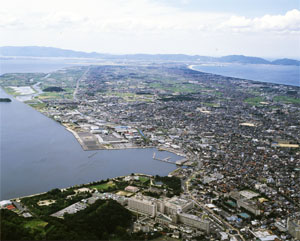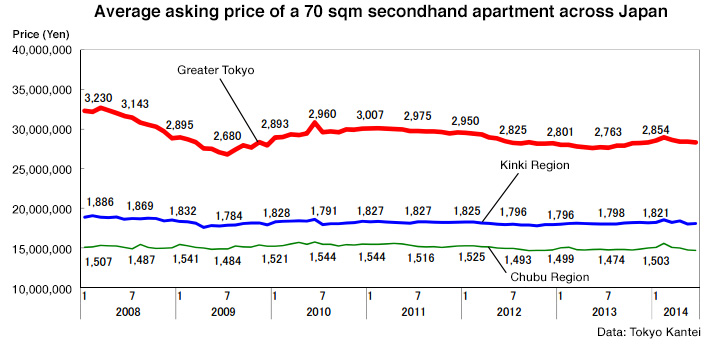Secondhand apartment prices in June - Tokyo Kantei
July 24, 2014Real Estate News,Market Information,All,Osaka,Nagoya,Tokyo
According to Tokyo Kantei, the average asking price of a 70 sqm (753 sqft) second-hand apartment in Tokyo’s 23 wards was 41,630,000 Yen in June, down 0.3% from the previous month but up 4.8% from last year. This is the first time in 7 months that prices have fallen from the previous month, although they continue to remain above 2013 levels. The average apartment age was 22.0 years.
In central Tokyo’s six wards (Chiyoda, Chuo, Minato, Shinjuku, Bunkyo and Shibuya), the average apartment asking price was 57,570,000 Yen, down 0.1% from the previous month but up 7.7% from last year. The average apartment age was 22.0 years.
The average price across greater Tokyo was 28,310,000 Yen, down 0.4% from the previous month but up 2.2% from last year.Read more
Tottori's 2nd largest city cannot afford to maintain its public buildings
July 23, 2014Tottori Prefecture,Yonago CityReal Estate News,All
 Yonago City in Tottori Prefecture is facing a looming crisis as the city’s finances cannot cover the growing maintenance bill required for its ageing public buildings.
Yonago City in Tottori Prefecture is facing a looming crisis as the city’s finances cannot cover the growing maintenance bill required for its ageing public buildings.
It was estimated that the maintenance and reconstruction costs for its 1,282 city-owned buildings would amount to 215.4 billion Yen (2.1 billion USD) over the next 40 years.
No progress made in faulty building in Yokohama
July 22, 2014YokohamaBuyer Beware!,Real Estate News,All
 It has been a month since news came out about a 11-year old apartment building in Yokohama that was starting to tilt due to a construction mistake.
It has been a month since news came out about a 11-year old apartment building in Yokohama that was starting to tilt due to a construction mistake.
The building’s owners association have been fighting with developer, Sumitomo Realty & Development, for several years over the issue. Last month it was announced that Sumitomo had asked the residents to move out and are in the process of arranging temporary accommodation.
Built in 2003, Park Square Mitsuzawa Koen is a five-building complex containing 262 apartments. Three years after completion, residents noticed that the guardrails in the hallway connecting one building to the other were out of alignment and cracks had formed where the rails were joined together. Sumitomo insisted that this was just a result of absorbing shocks caused by earthquakes. The owners association only found out that one of the buildings was leaning after carrying out an investigation during large-scale maintenance and repair work in 2013. Sumitomo again insisted that the building was safe and that there was no problem. They also said that any repair costs should be borne by the apartment owners. Read more
An updated forecast of Tokyo real estate prices
July 21, 2014Tokyo apartment pricesReal Estate News,Market Information,All,Tokyo

The Japan Real Estate Institute published an updated forecast of real estate prices and rental values in Tokyo’s 23 wards from 2014 to 2020.
In 2013, apartment prices increased by around 4% due to a last minute buying rush before the hike in the consumption tax kicked in. Note: this tax applies to the sale of brand new apartments and applies to the building portion of the sale only. Anyone who signed a contract on a new apartment before the end of September 2013 could lock in the 5% tax rate.
2014
In 2014, apartment prices are forecast to fall by around 2% from the previous year to 804,000 Yen/sqm. This was attributed a drop in demand due to the increase in the consumption tax rate from April 2014.
Monthly apartment rent increased by 6.4% to 3,430 Yen/sqm.
2015
Office vacancy rates in June - Miki Shoji
July 18, 2014Tokyo Office Market,Tokyo Office Rent,Japan Office Vacancy RatesOffice/Retail News & Information,Real Estate News,Market Information,All,Osaka,Nagoya,Tokyo

According to Miki Shoji’s office report, the office vacancy rate in Tokyo’s five central business districts (Chiyoda, Chuo, Minato, Shinjuku and Shibuya) was 6.45% in June, down 0.07 points from the previous month and down 2.01 points from last year.
The vacancy rate in brand new buildings was 18.09%, down 2.33 points from the previous month but up 6.49 points from last year.
It is not just large-scale office buildings that are experiencing better conditions, but mid-size buildings are also seeing a boost in demand. All 11 buildings developed under Nomura’s mid-size office brand ‘Premium Midsize Office (PMO)’ are almost fully occupied. Mitsubishi’s renovated small-to-mid sized office building in Kanda is also almost fully occupied. The building has attracted several IT-related tenants who want the freedom to design their own office space. Read more
June rental data - Tokyo Kantei
July 17, 2014Tokyo rental marketReal Estate News,Rental Market,Market Information,All,Osaka,Nagoya,Tokyo
According to Tokyo Kantei, the average monthly rent of a condominium apartment in greater Tokyo was 2,609 Yen/sqm in June, down 0.5% from the previous month but up 2.7% from last year. All areas within greater Tokyo saw rents decline from the previous month.
The average apartment size was 59.37 sqm and the average building age was 18.7 years.
The average rent in Tokyo’s 23-ku was 3,174 Yen/sqm, down 0.7% from the previous month but up 2.4% from last year. The average apartment size was 56.38 sqm and the average building age was 16.9 years.Read more
New apartment supply dwindling in Tokyo
July 16, 2014Real Estate News,Market Information,All,Tokyo
According to the Real Estate Economic Institute, 3,503 brand new apartments were released for sale across greater Tokyo in June, down 18.5% from the previous month and down 28.3% from last year. This is the fifth month in a row to see a year-on-year decline.
2,683 new apartments were sold, making the contract rate 76.6%. This is 2.3 points lower than the previous month and 5.0 points lower than last year. A contract rate above 70% suggests a strong market. According to REINS, 2,812 second-hand apartments were sold in June, exceeding the number of new apartments sold.
The average new apartment price was 48,300,000 Yen, down 6.3% from the previous month and down 0.1% from last year. The average price per square meter was 683,000 Yen, down 5.4% from the previous month and down 0.4% from last year.Read more


